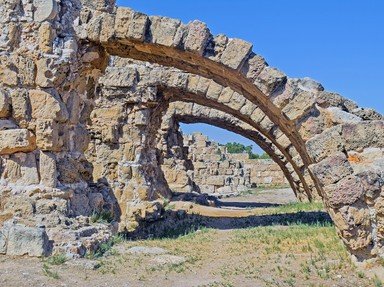Quiz Answer Key and Fun Facts
1. When in 1960 the remains of an Norse settlement was discovered this finally put to rest the discussion whether Norsemen really had landed in the Americas before Columbus. The site was named L'Anse Aux Meadows and is the only confirmed Norse settlement in America (outside Greenland). Where can we find L'Anse Aux Meadows?
2. Once the capital of the proud Aztec empire Tenochtitlan was one of the biggest cities in the world. Built on an island in lake Texcoco this magnificent city was crossed by canals and dotted with palaces and temples. Today all what's left of it are the foundations of the Templo Mayor and a minor site in Tlatelolco. The lake is drained and al what was left of the Aztec buildings is built over by a modern city. Which city lies where once Tenochtitlan stood?
3. There are many pyramids in Northern Peru, however, you might not notice them at all since they were made of mud brick and so heavily eroded they look like hills from afar. Near two of those pyramids burial sites have been discovered containing riches that can only be compared with those from Tutankhamun's tomb. The site was named 'the tombs of the Lords of Sipan', after the village where it was found. To which pre-Columbian culture do these tombs belong?
4. This island is home to the neolithic sites 'Ring of Brodgar' and 'Stones of Stennis'. In between both sites archaeologists have excavated a site they named 'Ness of Brodgar', which gives us unprecedented insight in the lives of stone age people. On which island can you find all this, as well as Skara Brae, a well preserved neolithic village?
5. On the outskirts of Tunis you can find what little remains of a city that once competed with Rome for domination of the Mediterranean. After more than a century of warfare this city finally lost out to Rome and was completely destroyed, although it later was rebuilt by Emperor Augustus. Which ancient city is this?
6. You may not suspect that Tell El Amarna, located somewhere in the desert far away from the famous sites, was once Egypt's capital city. It was founded by one of the most eccentric of Pharaohs. He revolutionized Egyptian art and was the first ruler to embrace monotheism. Who was this remarkable pharaoh?
7. Near the modern city of Selçuk in Turkey you can visit Ephesus, one of the best preserved Greco-Roman cities where a lot of ancient buildings are still left for us to see today. Unfortunately the same can't be said about one of the ancient wonders of the world that used to be within this city. It was destroyed and rebuilt several times until its final destruction by Gothic invaders. Which ancient wonder of the world is this?
8. In the 1960s a group of archaeologists excavated Çatalhöyük, a large neolithic village located southeast of present-day Konya, Turkey. It soon became clear that something we normally would expect in a neolithic village was missing. What is peculiar about Çatalhöyük?
9. Quite a lot is left of the Indus Valley Civilization, also known as Harappan Civilization (named after one of its major cities). Just like Egypt owes its existence to the Nile and Mesopotamia to the Euphrates and Tigris, this civilization thrived because of its location between the Indus river and the now dried out Sarawati. Despite of this we don't have the same knowledge of this civilization as we have of Mesopotamia and Egypt. Which of the factors mentioned below is *NOT* a reason for this lack of knowledge?
10. If you're ever in India you may come across pillars or stones with incomprehensible scribblings carved in them. Chances are you've stumbled on the edicts of one of India's most important rulers. He was largely forgotten until a British archaeologist deciphered his words. This ruler spent many years waging war but eventually came to regret the bloodshed and misery he had caused. Filled with remorse he embraced Buddhism. Who is this king of the Mauryan dynasty who turned Buddhism from an insignificant sect into one of Asia's dominating philosophies?
Source: Author
AlonsoKing
This quiz was reviewed by FunTrivia editor
stedman before going online.
Any errors found in FunTrivia content are routinely corrected through our feedback system.
